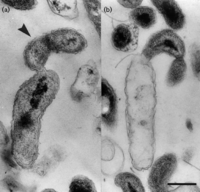Bdellovibrio exovorus: Difference between revisions
No edit summary |
No edit summary |
||
| Line 2: | Line 2: | ||
<b>This Funk [[Microbial Biorealm]] <i>Genus </i>template page is a guide for each student when creating and adding an entirely new species to MicrobeWiki. COPY AND PASTE this entire template (below) to set up a new page for a new species entry, then begin to fill in and edit the page. State at the bottom of the page that the page is "Authored by [your Student Name]" in front of "a student of CJ Funk at John Brown University".</b> | <b>This Funk [[Microbial Biorealm]] <i>Genus </i>template page is a guide for each student when creating and adding an entirely new species to MicrobeWiki. COPY AND PASTE this entire template (below) to set up a new page for a new species entry, then begin to fill in and edit the page. State at the bottom of the page that the page is "Authored by [your Student Name]" in front of "a student of CJ Funk at John Brown University".</b> | ||
[[File: Bdellovibrio_exovorus.png]] | [[File:Bdellovibrio_exovorus.png|200px|thumb|left|alt text]] | ||
==Classification== | ==Classification== | ||
Revision as of 09:00, 13 February 2017
This Funk Microbial Biorealm Genus template page is a guide for each student when creating and adding an entirely new species to MicrobeWiki. COPY AND PASTE this entire template (below) to set up a new page for a new species entry, then begin to fill in and edit the page. State at the bottom of the page that the page is "Authored by [your Student Name]" in front of "a student of CJ Funk at John Brown University".
Classification
Higher order taxa
Domain: Bacteria Phylum: Proteobacteria Class: Deltaproteobacteria Order: Bdellovibrionales Family: Bdellovibrionaceae
Species
|
NCBI: [1] |
Bdellovibrio exovorus
Description and significance
a. Bdellovibrio exovorus is a parasitic bacterium whose name means “Leech-like vibrating outside-devourer.” (Gr. Bdella, leech, sucker; L. vibrio, vibrating; Gr. exo-, outside, L. vorus, to eat.) B. exovorus was first isolated from sewage in London, Ontario, Canada, and sequenced in 2013 by the Weizmann Institute of Science.
b. B. exovorus are gram-negative, comma-shaped rods, about 0.5 um wide and 0.5-1.4 um long. They have a single, polar, sheathed flagellum that is 29 nm wide. These predatory bacteria have 2 phases in their life cycle: first, they swim freely to attack bacteria, and second they attach to the outside of their prey. Unlike their closest relative B. bacteriovorus, they do not burrow inside their prey cell, they have no periplasmic stage, and they do not form a bdelloplast. They grow by binary fission while attached to the prey cell. As it feeds, it leaves behind small plaques on the empty husks of their stalked prey cells.
Existing genus MicrobeWiki Link: https://microbewiki.kenyon.edu/index.php/Bdellovibrio
Genome and genetics
a. To what major branch of the prokaryotes do they belong? (see textbook or Bergey’s). List 2-3 closely related but separate species or genera of bacteria.
b. Briefly describe any extra-chromosomal elements or genetic tools that are used to study the bacterium: viruses, plasmids, transposons that allow genetic manipulation and analysis.
c. Has the genome or genomes been sequenced? If so, include the website for the database and one or two highlights of the genome. Also indicate genome size (base pairs), %G+C (nucleotide base composition) and number of genes, and specific genes or gene regions that are unique to this organism. If it has not been sequenced, give its closest relative that has been sequenced, its website, and some general information about the related sequence.
Example: The sequence of Haemophilus influenzae was determined using whole genome shotgun sequencing (Fleischmann et al. 1995).
Nutrition and metabolism
a.Describe the growth characteristics of your bacterial species; sources of C, N, electrons; respires/ferments, uses O2, etc.
b.What kinds of culture conditions (temp, pH, media) are needed for laboratory study?
c.What kinds of waste, by-products, volatile compounds are generated?
Ecology / Pathology
Ecology: How is your microorganism important in the ecosystem where it is found? How does it impact other organisms in the environment (could be positive or negative impact)?
Pathology: How does the microbe cause disease as it interacts with the host? Describe any specific toxins or pathways that are used for invading and causing disease in the host. What treatment is used to inhibit or kill the microbe?
Current Research
Describe recent research and findings that have been done with this organism. The research can be clinical, applied or basic research. This section should be based on 2 recent papers (10 years or less) and summarized in your own words.
References
The format for citations and for the “References” list will follow the “Citation—Name” Council of Science Editors (CSE) format, as the suggested formatting method listed on the MicrobeWiki Home page. The reference list will be numbered based on an alphabetical list of the first author’s last name.
A style guide for the CSE format can be found here: http://writing.wisc.edu/Handbook/DocCSE_CitationSystems.html.
For an example, see this entry: https://microbewiki.kenyon.edu/index.php/Bacillus_anthracis
Authored by [Kip Pierce], a student of CJ Funk at John Brown University

